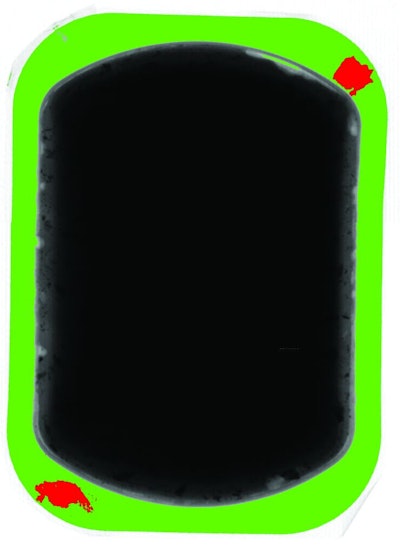
The latest generation of X-ray inspection technology can detect seal issues of packaged poultry products with unprecedented accuracy, identifying, for example, even tiny skin fragments breaching a package’s airtight seal.
Use of the technology means that processors can be assured that only correctly packaged chicken will leave the plant, helping to avoid customer complaints about meat that may have spoiled.
How it works
The technology generates two or more images from a single detector – one optimized for the product and one for the seal area.
Even a small amount of an ingredient trapped in the seal can be detected – down to just 50 microns thick – roughly the diameter of a human hair. X-ray seal inspection can cope with non-transparent packaging and items with pack colors that are all very similar, which can be difficult for vision detection systems.
Sealing with plastic, metalized film or foil material – whether in the form of flow-wrap packaging, form fill seal or thermoformed trays – means there is a bond between one or more surfaces of a film material and a substrate, such as the lip of a tray. The seal can become ineffective for various reasons.
The two sides of the seal can simply not be bonded together, resulting in a blown seal, or food matter can be trapped between the sealing surfaces, creating a non-sterile channel.
There are clues to the presence of contamination, allowing hotspots in the seal region to be identified. For example, the presence of a strand of food adjacent to the seal region will indicate that material on the seal has been extruded away from the sealing surface.
These hotspots trigger implementation of an algorithm to enhance the detectability of small seal defects that might be missed by human inspectors.
Foreign body detection
Another advantage this technology offers poultry processors is end-of-line inspection of the package contents for the traditional range of foreign bodies.
A pack of ground chicken, for example, will need to be inspected for metal and bone fragments.
Traditionally, this has required two X-ray systems – one for the seal and one for the product inspection – as the product inspection requires the penetration of a considerable thickness of food material in the package. This has meant duplication of a significant amount of expensive hardware.
The new generation of X-ray technology, however, can produce two sets of output data simultaneously.
The first output creates an image suitable for contaminant detection within the product, and also defines where the product is within the packaging. The second output uses this data to define the seal inspection zone, where it creates an image of much higher sensitivity.
Combining these two different types of inspection in a single unit means a simplified set-up and product changeover, as well as combined statistics and just one interface to factory information systems.
How X-ray vision is keeping track of chicken nuggets
















